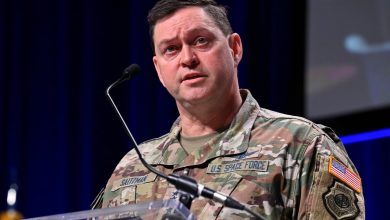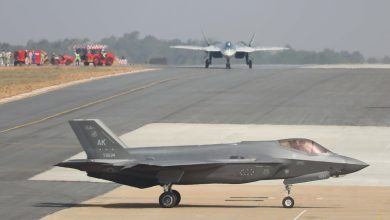Europe’s to-do list for defense without the US
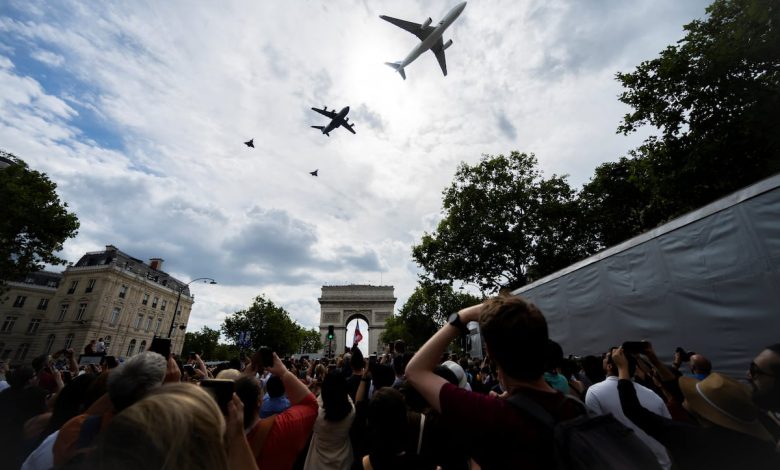
PARIS — Europe can build up most of the critical defense enablers needed to deter or defeat Russia without U.S. support within five years, provided the political will to invest is there, according to security researchers and experts surveyed by Defense News.
European countries currently rely on the U.S. within the NATO alliance for a range of supporting capabilities and assets that allow combat forces to operate effectively. That dependency looks increasingly precarious as U.S. President Donald Trump signals willingness to abandon America’s long-time allies and align with Russia.
Without critical enablers now provided by the United States, such as battlefield command and control (C2), satellite intelligence and long-range strike, an alliance of European Union countries, the U.K. and Norway could still defeat Russia in a conventional conflict, but it would be a costlier and bloodier affair, according to several analysts.
“At a European level we’re actually not fully operational without those enablers,” said Sven Biscop, director of the Europe in the World program at the Egmont Royal Institute for International Relations in Brussels.
“That doesn’t mean you can’t do anything, but it would be much more improvised. Much bloodier, with more losses of people, of terrain also – so we have to solve that urgently.”
Military satellite communications is the area where Europe is closest to having sufficient capability, with unmanned intelligence, surveillance and reconnaissance (ISR) not far behind, based on the assessment of 17 experts from mostly Europe-based think tanks and institutions. Those capabilities are either in place or fewer than three years away, a majority said.
Defense News asked the experts how much time a European alliance will need to reach adequate capacity in nine defense enablers, in order to deter or successfully fight Russia without the U.S.
Battlefield command and control, long-range strike and suppression of enemy air defenses (SEAD) are all areas where most analysts expect Europe can achieve self sufficiency within five years. Space-based ISR stood out as the capability for which the respondents were least optimistic, with a majority considering Europe will need five to 10 years to have sufficient capacity to stop relying on the U.S.
“We’re almost completely dependent on U.S. intelligence for satellite and everything that goes with it,” Biscop said. “That will take some time to develop, we will need a number of years.”
The experts were divided on aerial refueling and strategic airlift, with one group considering that Europe has enough tanker aircraft and transport aircraft as it is, and another set of analysts considering the continent still needs three to five years to achieve sufficient mass.
Airborne surveillance was another area of divided assessments, with around half of the analysts considering that Europe has the capability in place or can achieve critical ability within three years, and the other half expecting that to take anywhere between three and 10 years.
All the estimates are contingent on European governments being willing to cough up the money required to build up the enablers, with only a handful of NATO members in Europe spending more than 2.5% of their GDP on defense in 2024, and nearly a third not meeting the 2% target set by NATO in 2014.
“It’s difficult to forecast the number and size of capabilities we would need to be fully efficient against Russia,” said Héloïse Fayet, a researcher at the Institut Français des Relations Internationales, where she’s in charge of deterrence and proliferation. “There are a lot of external variables, such as the political willingness to spend much more money on defense.”
Russia could be ready to attack a European Union country within three to ten years, researchers Alex Burilkov at Globsec GeoTech Center and Guntram Wolff at Bruegel wrote in a Feb. 21 analysis, citing assessments by NATO, Germany, Poland, Denmark and the Baltic states.
European NATO allies have time to prepare, but “this time must not be spent doing nothing, as Europe is used to doing,” said Léo Péria-Peigné, a researcher at IFRI who specializes in armament capacity, and who doesn’t expect Russia to be a threat to the EU for at least five years because of its losses of troops and equipment in Ukraine.
European solutions for enablers “are critically under-financed right now, and it would be foolish to say anything else, but they exist,” said Péria-Peigné. “So it can ramp up, and we have time to do so. How much time will Europe need to build up capacity? If everybody is actually doing instead of talking, in five years it will be pretty solid.”
Europe wouldn’t need to match the U.S. in enablers, as its ambition is territorial defense rather than global, Biscop said. “You may not want to have the same numbers, but it is still a major investment.”
“Ukraine held Russia at the gate without most of these enablers, and it took most of the might of Russia.”
— Léo Péria-Peigné, IFRI
The example of Poland’s military expansion shows capabilities can be built up quickly when governments commit the finances, according to Péria-Peigné. And Europe may not need top notch capabilities to defeat a Russian attack, he said.
“Russia is not China,” Péria-Peigné said. “Ukraine held Russia at the gate without most of these enablers, and it took most of the might of Russia. I’m not saying it’s easy and we can do without, but we can fight Russia without all of the enablers, and we still have a lot of them.”
Some analysts mentioned enablers that were not in the survey, such as combat engineering and wet-gap crossing, airborne electronic attack and improved military mobility,
“Enhanced military mobility is a critical enabler to ensure deterrence,” said Mihai Sebastian Chihaia, an analyst at the European Policy Centre. “Currently, the state of infrastructure and regulatory issues are seriously impeding the movement of armed forces across Europe.”
Enablers provide supporting effects that boost the effectiveness of direct combat forces, and several analysts pointed out that Europe would also need to build up its troop numbers and add tanks, artillery and other equipment to compensate for the U.S. withdrawing from the continent.
“Land warfare is the most critical capacity to build up, because the worst case scenario is a Russian invasion of the EU proper, and scaling up land warfare capabilities rapidly would make a Russian breakthrough improbable, which after the lessons of 2022 would factor heavily in the Kremlin’s decision making,” Burilkov told Defense News.
A U.S. withdrawal, combined with a U.S.-Russia deal over Ukraine that would allow for a continued Russian military build-up, would require Europe to add capacities equivalent to the fighting force of 300,000 U.S. troops, with a focus on mechanized and armored forces, Burilkov and Wolff wrote in their report.
“We do have the people and the scale, we also have a much larger economy, so we would win a conventional war against Russia,” Biscop said. “What we need is to complete our European force package, so that you’re fully operational, which then works as a deterrent. To make the Russians think: `We’re not going to start this.’”
Below are the results of the survey asking the question how much time a European alliance would need to reach adequate capacity in nine enablers in order to deter or successfully fight Russia without the U.S. The results are based on 17 responses, except for satellite communications, airborne surveillance and strategic airlift, which received 16 responses, and SEAD with 15 responses.
Space-based ISR
Space-based ISR uses satellites to collect intelligence, conduct surveillance and perform reconnaissance. This provides critical information about enemy forces, terrain, and other factors to support decision-making and boost combat effectiveness.
The U.S. had 246 military satellites as of May 2023, according to the Union of Concerned Scientists, compared to 49 for European NATO members, led by France with 15 satellites.
“European efforts to expand space-based ISR capabilities are being hampered by the lack of an operational space port on the continent, limited launch capacity, and differing space-launch philosophies between the major European players. Without much improved space-based ISR capabilities, other European capability development efforts, such as the European Long-Range Strike Approach, will suffer from exceedingly long kill chains”
— Rafael Loss, European Council on Foreign Relations
Battlefield command & control
Battlefield command and control refers to the system and processes used by military commanders to direct and coordinate forces during operations.
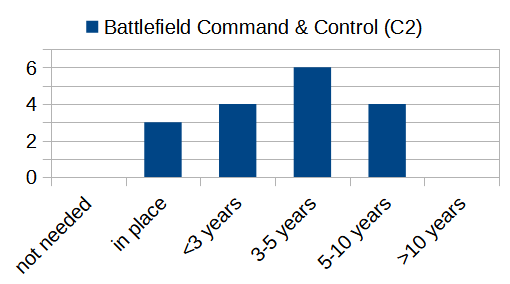
“There will not be a convergence on one C2 network, but rather an emergence of C2 clusters around different coalitions/missions.”
— Loss, ECFR
Long-range strike
Long-range strike involves weapon systems to deliver a conventional payload at stand-off range and with high precision, in order to achieve strategic or operational goals such as destroying critical infrastructure or high-value targets.
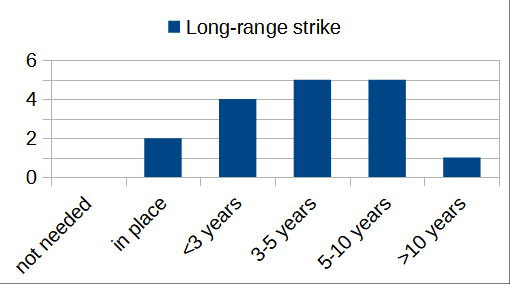
“Europeans possess some number of air-launched long-range strike systems, but they lack arsenal depth and should be complemented with sea-based and land-based long-ranged strike.”
— Loss, ECFR
Suppression of enemy air defenses (SEAD)
SEAD involves actions to neutralize or degrade enemy air-defense systems to create a safer operating environment for friendly aircraft.
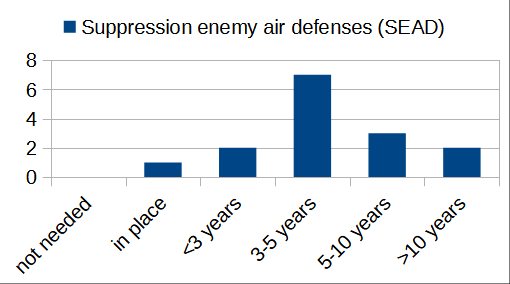
Aerial reconnaissance / aerial ISR
Aerial reconnaissance uses aircraft, including unmanned aerial systems, to gather visual or electronic intelligence about enemy forces, terrain, and other areas of interest.
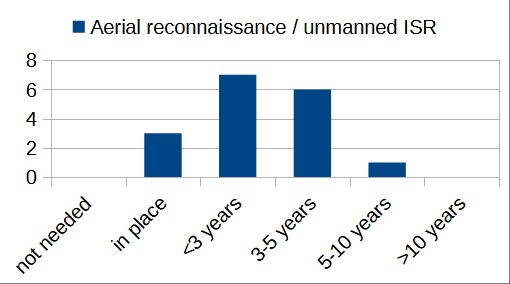
Poland has developed unmanned ISR capability over the past 10 years in response to developments in Ukraine, according to Péria-Peigné. “Not everybody is well equipped, but it exists.”
Satellite communications
Provides secure and reliable communication links for military forces across large areas.
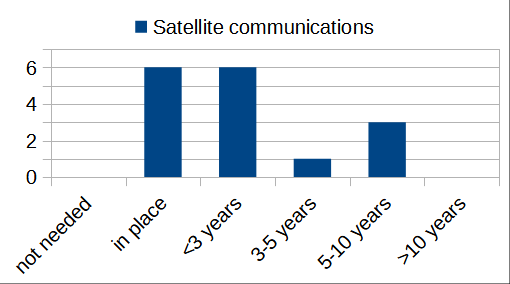
Europe has a number of communication satellites in space, and using them for military purposes is a political decision, several analysts said.
Airborne surveillance
Uses aircraft equipped with sensors and communication systems for a comprehensive view of a battle space, tracking aircraft, ships and other assets to enhance situational awareness for friendly forces.
“It depends. If you talk about U.S. armed forces getting out of Europe, it’s in place. If you talk about the U.S. switching off all European devices made in the U.S., it’s not in place.”
— Péria-Peigné, IFRI
One potential area of uncertainty is whether Europe would have access to the multinational fleet of 17 Boeing E-3A AWACS aircraft operated by NATO.
“This is … going to take a long time, to have all of that ourselves.”
— Biscop, Egmont
Aerial refueling
Allows for fighter jets and other aircraft to receive fuel in flight, extending their range and loiter time, and allowing for long-duration missions such as keeping a persistent presence over an area.
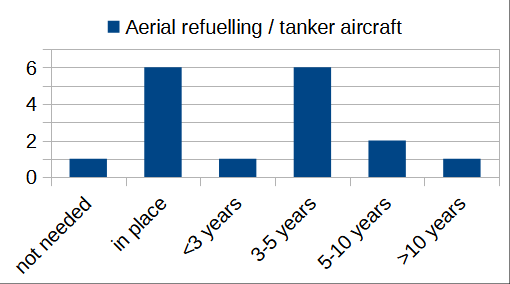
European countries operate 34 Airbus A330 Multi Role Transport Tankers, including eight in a NATO pool, with another eight on order, according to Airbus numbers as of Jan. 31.
“Here we have quite a lot already” – Biscop, Egmont
“On the refueling tankers we have a very good Europe solution” – Péria-Peigné, IFRI
“The A330 MRTT is a proven success, but the numbers in the MRTT pool are too low.”
— Dick Zandee, Clingendael
Transport aircraft / strategic airlift
Allows for rapid and large-scale deployment of military personnel, equipment and supplies over long distances, supporting operations far from home bases.

Germany, France, the U.K., Spain, Belgium and Luxembourg combined operate a total 115 Airbus A400M heavy transport aircraft, with another 45 on order, according to Airbus data.
“There is too little, but the platform is there” – Biscop, Egmont
“Thanks to the A400 it’s quite solid. The A400 is enough for the European theater” – Péria-Peigné, IFRI
“Hard to assess because if strategic airlift is for force project beyond Europe, Europeans might prioritize in-theater airlift given risk of U.S. disengagement.”
— Loss, ECFR
Rudy Ruitenberg is a Europe correspondent for Defense News. He started his career at Bloomberg News and has experience reporting on technology, commodity markets and politics.
Read the full article here

